In a world where the screws of surveillance are constantly tightening, where does that leave cryptocurrencies? Bitcoin is the dominant one, but it is only pseudonymous, not anonymous. The recent recovery of Bitfinex funds alone demonstrates that Bitcoin’s blockchain is both public and transparent.
In other words, if there are crumbs left over to tie one’s identity with a wallet address, crypto assets can be traced. Privacy coins like Monero (XMR) or ZCash (ZEC) is one way to keep the crypto part of the cryptocurrency alive. However, with so many funds already invested across the board, there are more elegant solutions to ensure online transactions remain private — like Tornado Cash (TORN).
In this guide:
What is Tornado Cash?
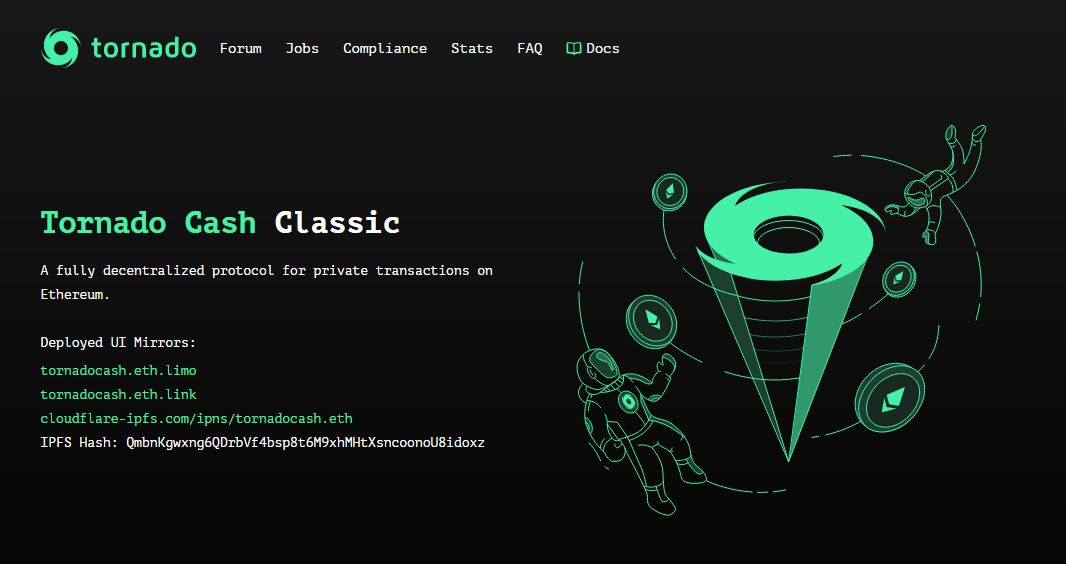
Like most decentralized protocols, Tornado Cash (TORN) is hosted on Ethereum as an open-source solution for anonymous token transfers. It stems from the previously mentioned ZCASH privacy coin, with developers building upon it to create the novel token mixing platform.
Because it’s on Ethereum, Tornado Cash uses ERC-20 token smart contract standard for its transactions. So far, it seems like any other protocol on Ethereum for depositing and withdrawing tokens, right? However, when tokens are either deposited or withdrawn from Tornado Cash, there is no link between that address and the new one.
SponsoredFor this reason, you can request your funds to be sent to Tornado Cash, and withdraw them into your non-custodial wallet. When this happens, the link between the initial sender is then severed, thus ensuring your financial privacy on a public blockchain like Ethereum.
A closer look at how Tornado Cash works
As you might guess, Tornado Cash shares its lineage with privacy coins like Monero (XMR) and Zcash (ZEC). Specifically, these privacy coins are private because they employ a critical piece of cryptographic technology — zero-knowledge proof.
Zero-knowledge proof (ZKP) is the most secure way imaginable by which authentication is done.
Why? Because it requires no passwords to be exchanged. Therefore, no passwords can be hacked. In other words, ZKP allows users to prove they are who they are without giving away their vital data.
Because of this authentication that doesn’t require disclosure of secrets, the protocol is called zero-knowledge proof.
One of the most popular illustrations used to demonstrate ZKP is the so-called Yao’s Millionaires’ problem. If two millionaires want to find out if they have the same amount of money, but without disclosing their own amounts, they would use ZKP.
The same principle applies to any situation in which proving identity without knowing is required.
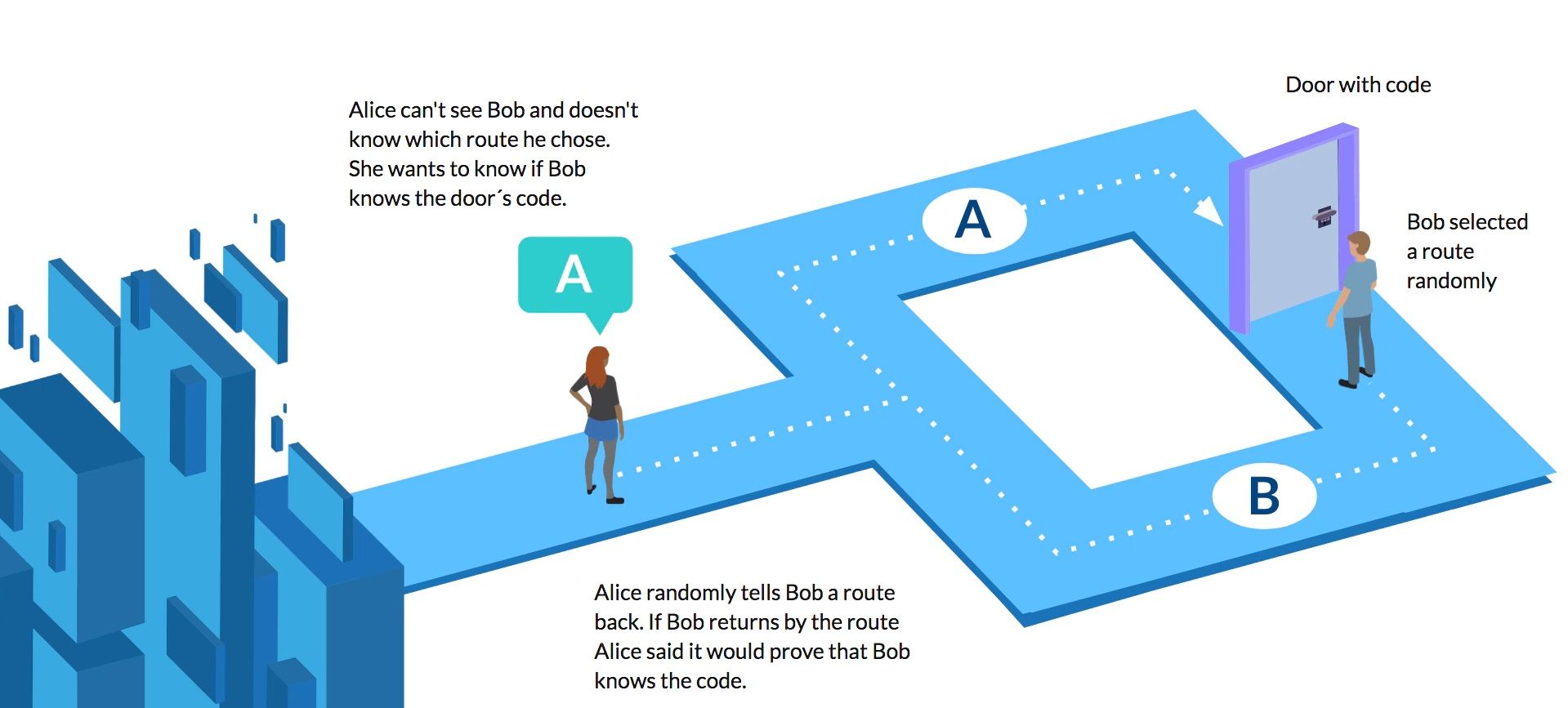
With the ZKP explanation out of the way, it is easy to understand how Tornado Cash works. Just like Alice (verifier) sends Bob (prover) a random route back to prove his identity, so does Tornado Cash generate a random key to deposit your ERC-20 crypto funds.

Using this random key generation between the sender and the receiver, Tornado Cash severs the on-chain link between wallets. In technical terms, both Zcash and Tornado Cash use a variation of ZKP called zk-SNARK proofs (short for zero-knowledge succinct non-interactive argument of knowledge).
The fastest way to get a grasp of this is to see it in action.
Tornado Cash in action
Let’s say you want to receive $100,000 from someone, but without any prying eyes tracking the transaction. Provided you already have MetaMask wallet installed in your browser, you go to tornadocash.eth.link. The sender would first have to connect the MetaMask wallet to Tornado Cash, just like with any other DApp.
Because DAI is a stablecoin, 100k DAI would equal $100,000.

When the MetaMask wallet is connected, Tornado Cash automatically checks if there is enough funds present when clicking on “Deposit.” As you can see, the sender cannot send a custom amount because each amount range has its own Anonymity Set.
Anonymity Sets are just batched series of transactions, waiting for withdrawal within smart contracts. Additionally, they display how many deposits can be withdrawn from.
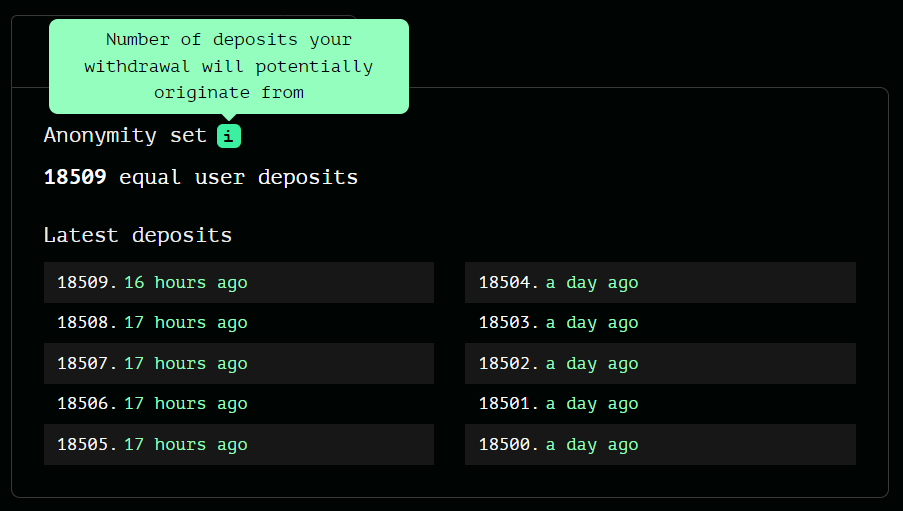
However, the new experimental version, Tornado Nova is available here, allowing for custom amounts.
In any case, when the deposit is completed, Tornado Cash generates a key with a secret hash, called a commitment or private note. The note is then tied to the deposited amount now held in Tornado Cash’s smart contract.
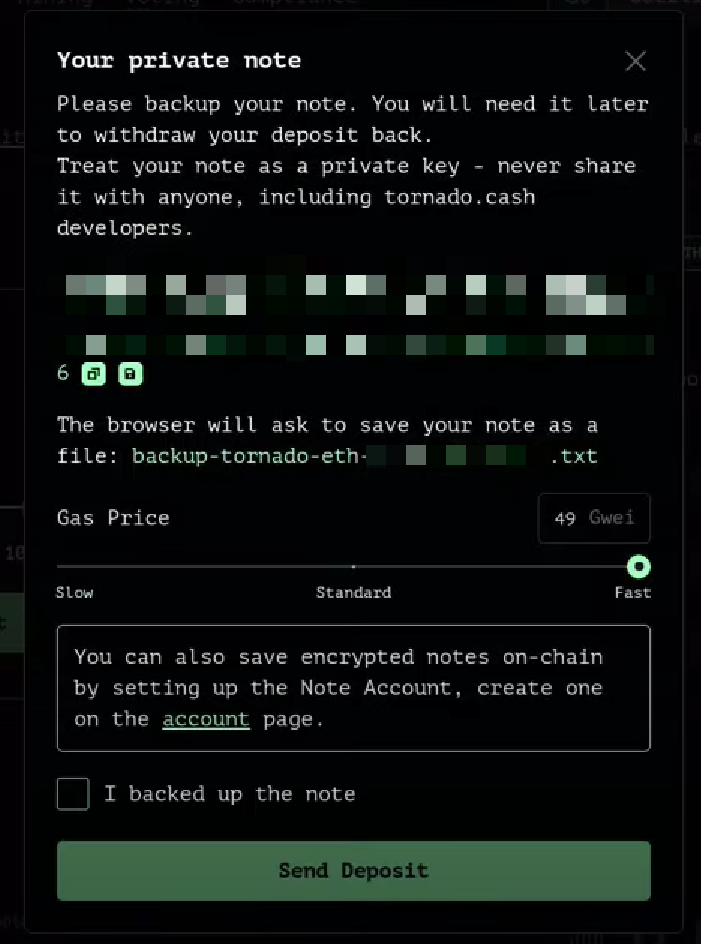
After the pop-up window to save the note as a text file launches, the sender can also rename the file to make organizing transactions easier. One should use a password manager with 256-bit AES encryption military-grade to store such files in a vault. Next, a MetaMask wallet window will open asking for the transaction to be confirmed.
At the withdrawal end of the transaction, it is recommended to wait until at least 5 confirmations are completed to ensure privacy. Finally, the receiver then submits the saved private note along with the recipient’s address.
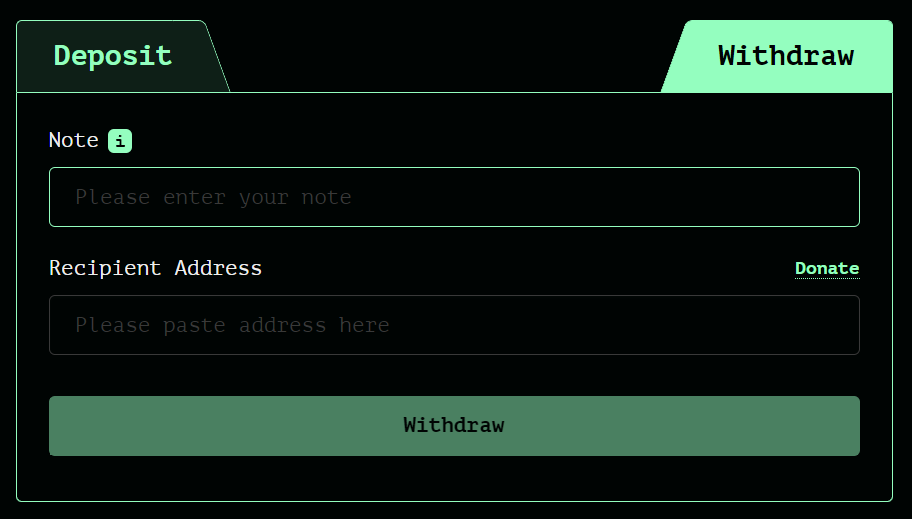
You can boost privacy even further
Of course, you can pick a different address from the one deposited, depending on which ones you have available for pasting in your MetaMask wallet. Upon clicking “Withdraw,” Tornado Cash will generate its zk-Snark proof, ensuring there is no on-chain data to tie the sender with the receiver.
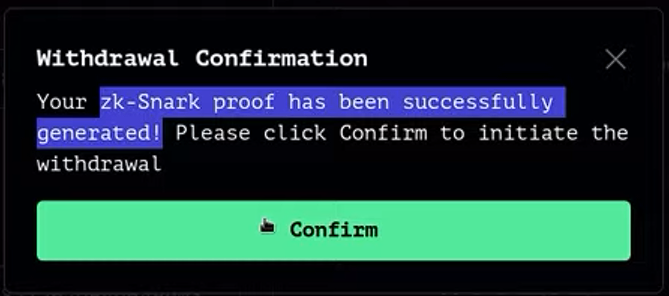
When looking at the transaction on Etherscan, the transaction with the amount will show up. However, because Tornado Cash anonymized it, it won’t matter. Only the Tornado Cash address will show up.
SponsoredAlternatively, instead of MetaMask, it is possible to use Tornado Cash Relayer with a brand-new Ethereum address for total anonymity. In that scenario, the withdrawal address doesn’t have to contain any ETH for gas fees, which elevates the privacy angle a notch further.
As the final step to fortify your online financial privacy, it is also advised to use either a VPN or Tor proxy to obfuscate your IP address as well. Lastly, take care to send tokens when ETH gas fees are at the lowest point, which is usually over the weekends.
Who is behind Tornado Cash?
The creators of this coin mixing service are Roman Semenov and Roman Storm. Although Storm has formal education in Metallurgical Engineering, he veered off course into blockchain technology since 2011. His previous work history includes Blockchainlabs.nz, Amazon, PepperSec, and a number of DeFi projects such as 0x, Aave, Compound, MakerDAO, and 1inch. Across these companies, he took part in auditing Solidity code, developing smart contracts and building ERC-20 tokens.
Roman Semenov’s education is equally impressive, having specialized in field theory and quantum statistics. He also worked at PepperSec as co-founder, alongside Viking Studio, a Russian social media marketing venture. Lastly, he worked at RedHelper to optimize e-commerce funnels and conversions.
They have used Zcash open-source code to develop Tornado Cash as another privacy-focused blockchain project. While Zcash is a standalone privacy coin, Tornado Cash is a coin-agnostic anonymity mixer service, making it achieve greater popularity.
What is TORN token?
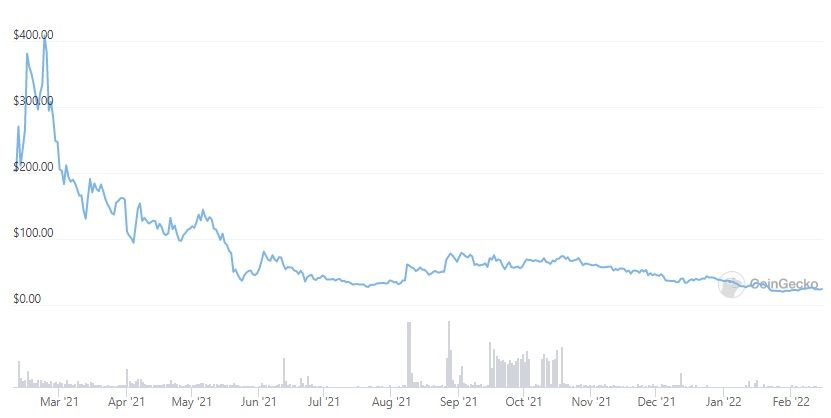
Like most smart contract protocols, Tornado Cash uses TORN tokens for governance and utility. In fact, TORN is the means by which the platform has become completely decentralized to the point where the team doesn’t have control over the protocol, according to co-founder Roman Semenov,
“The Tornado Cash team mostly does research and publishes the code to GitHub. All the deployments, protocol changes, and important decisions are made by the community via Tornado Governance DAO and deployment ceremonies.”
TORN tokens airdropped in Feb. 2021, accounting for 500,000 TORN tokens, or 5% of its total supply of 10 million. Immediately after the airdrop, TORN jumped by 200% to its ATH price of $436.16. However, it stayed relatively flat under $50 for the rest of 2021, up to this day at $24.13.
The bulk of TORN tokens is in the hands of the community and the treasury, at 55% (5.5 million TORN), gradually unlocked over a 5-year period. While developers and investors maintain 30% (3 million TORN) stake in TORN’s total supply. So far, Tornado Cash facilitated 2,547,731 ETH worth of transactions, or about $7.4 billion across 27,631 users.

What is important to know is that TORN tokens can be used for anonymity mining. If you had paid attention, you may have noticed that Tornado Cash has Anonymity Sets. Whenever users add Torn tokens to them, they receive rewards, hence the anonymity mining.
What is anonymity Mining?
This unique twist to liquidity mining exists because of the obvious reason. Mining pool deposits would be visible, defeating the privacy angle of Tornado Cash. With anonymity mining, users are protected from this through generated Anonymity Points whenever they deposit any token to Tornado Cash.
Then, these points are transferred to a special shielded account, removing deposit balance and wallet address info from the public spotlight. When a certain threshold is reached, the user can then convert Anonymity Points into TORN tokens.
This way, users can still receive TORN tokens as rewards for their privacy contribution, avoiding the usual liquidity mining pools. Speaking of which, these tokens can be traded on Binance, Mandala, BingX, Gate.io, and OKEx.
Reduce your Tornado Cash transfers by going outside Ethereum
While Ethereum is the Tornado Cash’s original home, you can drastically cut on transaction fees by using the mixer service on the following alternative blockchains, as well as layer 2 scalability solutions:
- Binance Smart Chain: BNB (Binance Coin)
- Polygon Network: MATIC (Polygon)
- Gnosis Chain (former xDAI Chain): xDAI (xDai)
- Avalanche Mainnet: AVAX (Avalanche)
- Optimism, as a Layer-2 for ETH (Ethereum)
- Arbitrum One, as a Layer-2 ETH (Ethereum)
The previously mentioned upgraded version of Tornado Cash is Tornado Cash Nova, allowing for custom deposits. In addition to this, Nova facilitates shielded transfers. In the present version, the tokens first needed to be withdrawn from a fixed pool amount to gain custody. With shielded transfers, they can be transferred to another address without first withdrawing them from the pool.
Even more importantly, Tornado Cash Nova uses a drastically cheaper Gnosis Chain (former xDai Chain) as L2 scalability protocol. This way, users receive affordability, security, and speed. However, having only been released in Dec. 2021, the protocol is still not fully deployed.
Is Tornado Cash (TORN) worth It?
It is clear that Tornado Cash will follow in the footsteps of Monero and Zcash. They are as valuable as users deem their privacy to be so. Generally speaking, it seems that most people prioritize convenience and simplicity over anonymity.
That seems to be the case, even if they have to pay more for the convenience, such as reporting their transactions to the IRS. Therefore, TORN token will cater to a niche of users who prize their online privacy more than convenience.
Nonetheless, as overall crypto adoption increases, that user base will also expand. Additionally, because Tornado Cash is very simple to use, is not limited to specific privacy coins, and runs cheaply, a strong case could be made that Tornado Cash (TORN) is bound to be even more valuable than specialized privacy coins.

